If you’re a homeowner, you’ll definitely have a heating/cooling system installed in your home. Based on your location, home size & other factors – the type of heating/cooling system would vary. In this article let’s learn more about types of heating/cooling systems and how to identify the one you’ve in your home. Basically, we can classify heating/cooling (HVAC) systems into two types based on the stages of heating/cooling provided – they are 1) Single Stage and 2) Multi-Stage – heating/cooling systems. Let’s see them in detail.
A single-stage HVAC system has only one stage of heating or cooling output. They are either running at full capacity (ON state) or not running at all (OFF state). A multi-stage HVAC system has more than one stage of heating/cooling output.
The most common multi-stage system is Two-stage heating/cooling system – which has two output levels of heating/cooling. A two-stage HVAC system will have a low setting & high setting suited for moderate climate conditions & extreme climate conditions.
If the winter/summer is not on the extreme side, you just need to run your two-stage HVAC on a “low setting” which will adjust your room temperature gradually. If the climate is on the extreme side, put your 2 stage HVAC on the “high setting” which will adjust your room temperature quickly.
Other than two-stage systems (the most popular and common model), there are three-stage & four-stage systems – in multi-stage heating/cooling systems. The cost of the system increases with the number of stages. In North America (USA & Canada), most of the homes run on single-stage or two-stage heating/cooling systems. Single-stage systems are the least priced & easy to install. But they have the disadvantage of lesser fuel efficiency & uneven heating (recall they are either running at full capacity or OFF). Two-stage systems cost high to install (& setup) but they are highly efficient (fuel costs would be lesser) & they provide even temperature to all rooms.
Do you know which type of HVAC system are you having in your home? If not, don’t worry! We will help you identify your type of heating/cooling system.
How to identify your heating/cooling system?
To know whether you have a single-stage or multi-stage system, check the number of wires leading into different terminals of the thermostat. A multi-stage system will have lots of wires to the thermostat whereas a single-stage system has only a maximum of two wires.
The very first step in identifying your HVAC system correctly is to first check if you are having a line voltage (120V/240V) system or a low voltage (24 volts) system in your home. If you have a line voltage system, you probably have an electricity-based heating or air conditioning system in your home. In such a case, you would be having a baseboard heater or a forced fan heater, or a wall heater in your home. Now if you have a low voltage system in your home, you would have a furnace-based system, or a boiler system or a heat pump (this could be single-stage or multi-stage).
Now how to identify if you have a line voltage system or low voltage system? This is very simple – just check your thermostat wiring. The easiest way is to check the backside wiring of your current thermostat. If you have a line voltage system, your thermostat (which would be a line voltage thermostat running on 120 volts/240 volts) would have either two or four wires coming out of its backside. These wires will be thick (just like your mains line wire) and the color of the wires will be either Black & Red or Black & White.
If you have a low voltage system, your thermostat (which would be a low voltage thermostat running on 24 volts) would be having 2 to 9 wires (or more) on its backside – which will be very thin sized and the wires will be having different colors like Green, Yellow, Red, White etc. Read our complete guide on how to identify between Low Voltage & Line Voltage Systems.
Identify between – Single Stage/Multi Stage – for a 24 Volts/Low Voltage System
In America, only 10% of homes run on line voltage systems (electricity-based systems). The big majority (about 90%) of homes in the USA & Canada run on central furnaces, boilers, or heat pumps – which are low voltage systems (which don’t need electricity to produce heat), and these systems are controlled using low voltage thermostats. These types of HVAC systems would be using a central furnace (in most cases) or a central boiler or a heat pump. In some cases, a combination of furnace & heat pump is used to set up the HVAC system. In any case (be it a furnace or boiler or pump), your HVAC can be either single-stage or multi-stage depending upon the levels of output provided by your system. This means it is possible to set up a single stage or multi stage system using a furnace or boiler or whatever source of energy. Our objective here is to identify if your system is Single-stage or Multi-stage – we are not bothered about if you have a furnace or a boiler.
Let’s see how we can do it easily! For this case also, let us grab the thermostat and look at its backside. Take the base off your thermostats and look at the wires. Check the wires going into terminals W, W1, Y, and Y1 in particular.
Identifying Single Stage HVAC Systems
Conventional Single stage systems – will have one wire leading into W or W1 terminal (for heating) and one wire leading into Y or Y1 terminal (for cooling). So that’s the easiest way to identify single-stage conventional HVAC systems (which would be furnace-based or boiler-based).
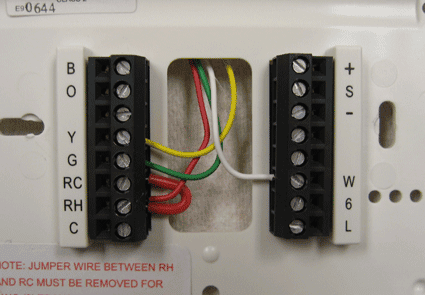
Single-Stage Heat Pumps – will have only one wire (for both heating and cooling) leading into the Y terminal.
Note: If the heat pump has an emergency heat/auxiliary heating facility, you will find a wire leading into the AUX terminal.
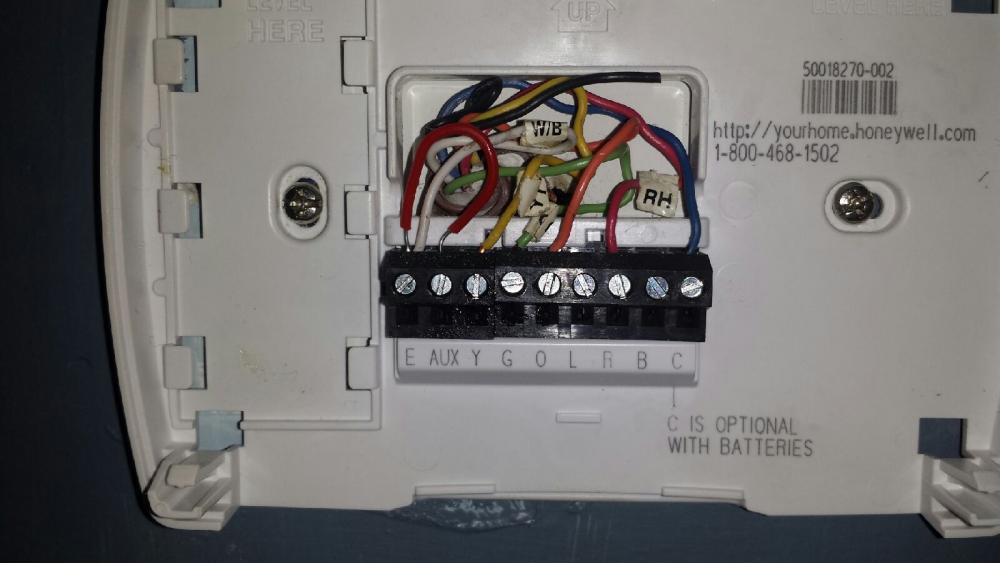
Identifying Multi Stage HVAC Systems
Multi-stage HVAC systems will have multiple wires (both for heating & cooling) leading into different terminals. The wires for heating purposes will be leading into terminals marked “W” (like W, W1, W2), and the wires for cooling purposes will be leading to terminals marked “Y” (like Y, Y1, Y2)
- 3 Stage conventional heating system – will have wires leading into W, W1 and W2 (or W1, W2 and W3) terminals of thermostat.
- 2 Stage conventional heating system – will have wires leading into terminals W and W1 (or W1 and W2)
- 2 Stage conventional cooling system – will have wires leading into terminal Y and Y1 (or Y1 and Y2)
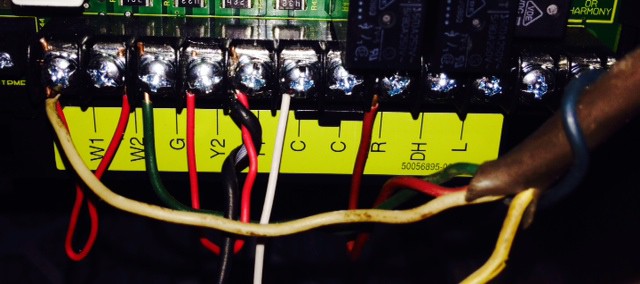
Note: This image given above is of a thermostat that supports 2 stage systems (2H/2C – 2 stages of heating(W1, W2) & cooling (Y1, Y2) in a single thermostat). But this thermostat is actually wired as 1H/1C system as there is a jumper wire connecting W1 to W2 and another jumper wire connecting Y1 to Y2. This could be because the HVAC was either single-stage or they wanted to use only 1 stage (possibly the moderate setting) of the 2 stage HVAC system. If the HVAC was a two-stage system, we would have seen two separate wires going into W1, W2, and another two wires (if the system has an air conditioner) going into Y1 and Y2 terminals.
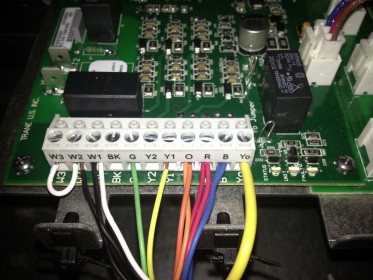
Note: This image above is a thermostat that supports 3H/2C. But it is wired for as 2H/2C (2 stages of heating & cooling). You can see the jumper wire connecting W3 to W2 – which wires the thermostats as 2H.
Some systems have emergency heating (or auxiliary heating)
Thermostat with Two Labels (Double Label)
In some cases, a thermostat will be having two labels at the terminals (as shown in the image below). One set is for conventional systems (furnace or boiler) and the other set is used if you have a heat pump.
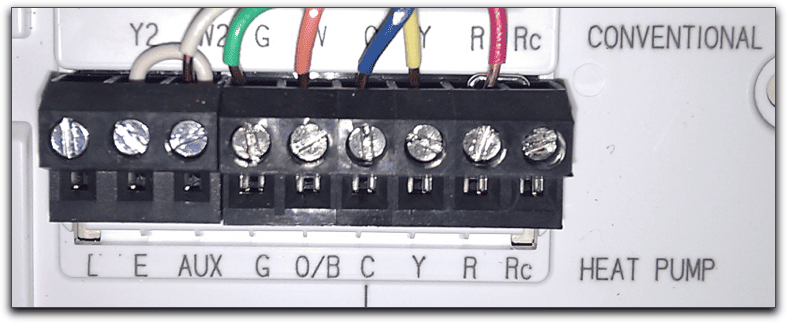
Note: In the image above, even though the wires are coming out of a label marked “conventional” – this thermostat is actually wired for “heat pump”. So be informed, in this type of case you can’t judge your HVAC system just by looking where the wires are coming out from. You need to have an idea of wiring diagrams in this kind of case.
